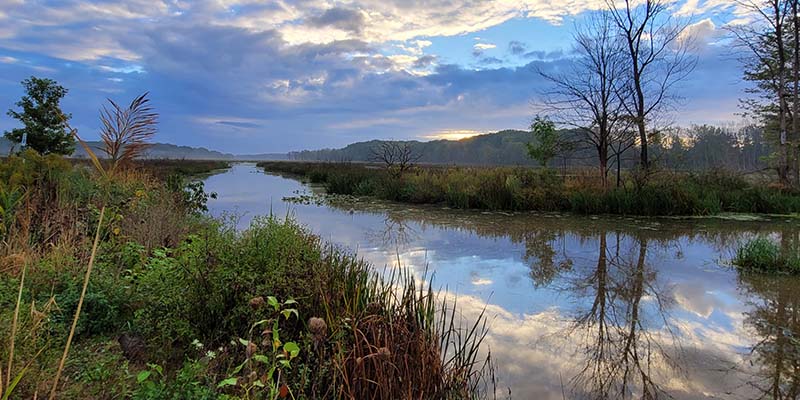
The Cleveland Museum of Natural History is currently engaged in the Mentor Marsh Coastal Restoration Project which includes the eradication of invasive Phragmites (common reed grass) and the re-establishment of native species. Here are answers to some frequently asked questions.
Why restoration at Mentor Marsh?
Designated a National Natural Landmark (1966) for being one of the most species-rich sites on the Great Lakes shoreline, the Marsh became dominated by one species, Phragmites australis. Large scale restoration began in Mentor Marsh in 2015 and is presently ongoing.
What are the next steps in our restoration?
We will continue to steward Mentor Marsh to eradicate invasive plants including Phragmites, non-native cattails, Purple Loosestrife and upland woody plants, too. In addition, we are planting plugs, trees, whips, live stakes of native plants, shrubs and trees to jump start biodiversity. Aerial spraying of cattails will occur mid/late September in the eastern basin, parallel to SR 44.
What is Phragmites?
Phragmites australis (Common reed) is an invasive wetland grass from Africa and Asia that is not native to North America. Before our resto-ration efforts, Phragmites outcompeted native wet-land plants. At an average of 225 stems in a square meter, or 1 stem every inch, Phragmites formed tall, dense impenetrable stands. Dead, dry stalks had been a fire danger to nearby residents and structures. City of Mentor and safety forces (Fire and Police Depts.) of many local communities have, altogether, spent more than $1million dollars fighting 13 large Marsh fires.
More about Phragmites
The plant can grow up to 6 meters (24 feet) high, spreads by roots (rhizomes) that can reach up to 2 meters (6.5 feet) underground and also by seed from flower heads.
Can Phragmites be removed by another method?
At over a million stems per acre in the 801-acre Marsh, not really successfully. Mature plants have sharp leaves, and deep roots that make digging pointless. Like most perennial grasses, re-sprouting occurs from any root material left in the ground, so prescribed burning or mowing is also not feasible. Flooding the Marsh basin would cause more problems.
What is being done to control it?
Controlling Phragmites requires a combination of aerial and ground herbicide application.
Who is leading the restoration effort?
Cleveland Museum of Natural History (CMNH) scientists, natural resource professionals and contractors.
Where and when will the restoration activities take place?
Our project area includes all of the nearly 4-mile-long Marsh. Phragmites herbicide application is August-November. Cattails is June – November.
What safety measures are used to protect people and homes?
A 23 meter (75 feet) wide “hand-spray only zone” buffer along the Marsh border ensures more precise treatment to protect plants at the edge of the Marsh. These plants are important for restoration and are targeted for protection. Aerial spraying only takes place within the interior portion of the Marsh, inside of the buffer area to protect shoreline trees from drift. Close monitoring of wind conditions has prevented any drift from harming trees during previous aerial applications. Additionally, during the aerial application, visitors are not allowed in the treatment areas.
What herbicide will be used?
U.S. EPA approved aquatic herbicide Rodeo®, a glyphosate compound approved for use in aquatic areas that does not harm aquatic organisms.
How does Rodeo® work?
The chemical kills plants by inhibiting the activity of certain enzymes that are pre-sent only in plants. Glyphosate then binds tightly to soil for up to 6 months before it is broken down by bacteria in the soil. Lake County Soil and Water Conservation District will continue conducting water quality sampling pre and post treatment.
How will this herbicide impact other plants and wildlife?
The only herbicides that are effective in controlling Phragmites and cattails are broad-spectrum or non-selective. Areas with established native plants are avoided during treatment. This herbicide was extensively tested as required by the U.S. EPA before the product was registered for use in the U.S. Testing on shows that the potential for unreasonable adverse effects to wildlife and other non-target organisms are minimized when used according to label instructions.
What safety measures will be used to protect the environment?
CMNH scientists and our restoration team are committed to protecting nature. Using best management practices, the herbicide has been diluted down to a very low 3-5% concentration to minimize the amount of herbicide used, but still be effective in killing Phragmites and cattails. To further reduce herbicide amounts, aerial application via helicopter reduces the volume sprayed as this application uses a mist of very fine water vapor versus applying larger water droplets with ground-based sprayers. Under U.S. EPA guidelines for aquatic toxicology, tests show that at very low concentrations the herbicide is practically non-toxic to sensitive organisms. For example, Leopard Frogs were first found in 2004 along the Wake Robin boardwalk after the Phragmites was eradicated there in 2003 using herbicides. These are now expanding Marsh-wide.
How will aerial application work?
A FAA-certified helicopter with an approved herbicide applicator license will spray herbicide just above the treatment area.
How will people be notified?
Via the web: Mentor Marsh Facebook page, City of Mentor website, public messages, mailings, canvassing of neighbors, signs at Mentor Marsh Nature Center and from CMNH staff.
Are there other areas in the Great Lakes where herbicides are used to control Phragmites?
Yes, this is a common restoration method of wetlands across the Great Lakes including Sandusky Bay/western Lake Erie marshes as well as Presque Isle State Park in Erie, PA.
What is the desired end goal?
A mosaic of native marsh plants and swamp forest trees. In 2016, CMNH staff documented over 60 species of native plants sprouting from the existing soil seed bank up through the flattened Phragmites! In 2018, 154 species were documented! In addition to the native plants responding on their own, from 2017-2021, staff, contractors, partners, volunteers and inmates planted over 236,000 plugs of 23 native wetland species in the eastern basin of Mentor Marsh. We also have aerially seeded the same species via helicopter.
How has wildlife responded?
Yellow Perch now use the Marsh as a nursery, and Northern Pike are spawning in the Marsh. Rare marsh birds such as Bitterns and Rails are now nesting in the restored habitat attracting birdwatchers who in turn contribute to our local economy.
How long will restoration take?
With each progressive year, more and more native plants grow from the soil seedbank and from plants now present. CMNH Land Stewards and Naturalists collect seeds around the Marsh from native plants such as Swamp Rose Mallow, Swamp Milkweed, Bur-reed and Blue-flag Iris for fu-ture planting. Contact the Nature Center to volunteer!
Restoration Partners: CMNH and Lake County Soil and Water Conservation District
Supporting Partners: Ohio Department of Natural Resources – Division of Natural Areas and Preserves, Ohio EPA WRRSP, Sustain Our Great Lakes, Great Lakes Restoration Initiative & The Nature Conservancy, Lake County Dept. of Utilities, City of Mentor Natural Resources, City of Mentor Fire Department and the many private landowners who have sold, donated or allowed restoration activities on their property.
